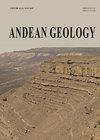Revisión de la Formación La Veteada en su estratotipo (La Rioja, Argentina): edad, estratigrafía y significado paleoambiental
IF 1.2
4区 地球科学
Q3 GEOLOGY
引用次数: 1
Abstract
The La Veteada Formation, in the Sierra de Famatina (west of Argentina), is one of the few records of Early Triassic age in South America verified by isotopic age and palynological assemblages. This unit is composed of sandstones, mudstones, shales, limestones, and marls, with some levels of gypsum, chert, and tuff levels. In its stratotype, the La Veteada Formation rests on Late Permian red beds of the Talampaya Formation and is covered by Neogene breccias and conglomerates belonging to the Del Crestón Formation. The unit is divided into three associations of sedimentary facies. Facies association A (80 m thick) is a red bed succession composed of mudstone and fine-grained sandstone, together with some levels of chert and gypsum. Facies association B (58 m thick) is greenish-gray to yellowish-gray and comprises limestones, marls, shales, and fine- to coarse-grained sandstones. This facies includes stromatolites and several levels of shales and marls where rich palynological assemblages were recovered. Finally, facies association C (24 m thick) is made up of yellowish-gray marls, mudstones, and sandstones. In this section, stromatolites are missing, thin levels of gypsum appear, and evidence of subaerial exposition as mud cracks and raindrop imprints are frequent at the top of the facies. The lithology, sedimentary structures, and vertical stacking of facies suggest that the La Veteada Formation was deposited in a lacustrine environment, which evolved from a shallow ephemeral playa lake system (facies association A) to a perennial lake, in which carbonate production increased compared to clastic sedimentation (facies association B). Regarding the facies association C, the increase in clastic supply, the missing stromatolites, and the presence of gypsum levels suggest a progressive shallowing of the lake and the likely transition to a palustrine environment. The Early Triassic age of the La Veteada Formation is indicated from two different lines of research. Firstly, a zircon U-Pb age of 249.66±0.11 Ma obtained from a tuff level at the middle part of the facies association A. Secondly, the presence of palynological species identified in other Early Triassic units worldwide. The La Veteada Formation records the filling of the embryonic extensional basins formed at the earliest Triassic. Moreover, this unit shows the evolution of depositional environments after the late Permian massive extinction event.回顾La Vetida地层的地层类型(阿根廷拉里奥哈):年龄、地层和古环境意义
La Veteada组位于法马蒂纳山脉(阿根廷西部),是南美洲为数不多的经同位素年龄和孢粉组合验证的早三叠纪记录之一。该单元由砂岩、泥岩、页岩、灰岩和泥灰岩组成,并有一定层次的石膏、燧石和凝灰岩。在层型上,La Veteada组位于Talampaya组晚二叠世红层之上,为Del Crestón组新近系角砾岩和砾岩覆盖。该单元被划分为三个沉积相组合。相组合A(厚80 m)为泥岩和细粒砂岩组成的红层序列,并伴有一定程度的燧石和石膏。相组B(厚58 m)为绿灰色至黄灰色,由灰岩、泥灰岩、页岩和细粒至粗粒砂岩组成。该相包括叠层石和几层泥页岩和泥灰岩,其中发现了丰富的孢粉组合。最后,相组合C (24 m厚)由黄灰色泥灰岩、泥岩和砂岩组成。在这一段,叠层石缺失,石膏薄层出现,地面暴露的证据,如泥裂缝和雨滴印记,在相的顶部频繁出现。岩石学、沉积构造和沉积相的垂向叠加表明,La Veteada组沉积于湖相环境中,由浅层短暂的盐湖体系(相组合a)演化为多年生湖泊,碳酸盐产量较碎屑沉积(相组合B)增加。石膏水平的存在表明湖泊逐渐变浅,并可能过渡到湖泊环境。La Veteada组的早三叠世年龄由两条不同的研究线确定。首先,在a相组合中部的凝灰岩层获得了锆石U-Pb年龄为249.66±0.11 Ma;其次,在世界范围内其他早三叠世单元也发现了孢粉物种。La Veteada组记录了早三叠纪形成的伸展盆地雏形的充填。此外,该单元还显示了晚二叠世大灭绝事件后沉积环境的演变。
本文章由计算机程序翻译,如有差异,请以英文原文为准。
求助全文
约1分钟内获得全文
求助全文
来源期刊

Andean Geology
地学-地质学
CiteScore
3.90
自引率
0.00%
发文量
17
审稿时长
>12 weeks
期刊介绍:
This journal publishes original and review articles on geology and related sciences, in Spanish or English, in three issues a year (January, May and September). Articles or notes on major topics of broad interest in Earth Sciences dealing with the geology of South and Central America and Antarctica, and particularly of the Andes, are welcomed.
The journal is interested in publishing thematic sets of papers and accepts articles dealing with systematic Paleontology only if their main focus is the chronostratigraphical, paleoecological and/or paleogeographical importance of the taxa described therein.
 求助内容:
求助内容: 应助结果提醒方式:
应助结果提醒方式:


